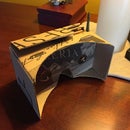Introduction: Invisible Art: Mosaics, Polarized Light, and 3D Glasses
This Instructable is written as a classroom lesson. Skip this intro and the Step 2 experiments if you just want to make it!
Light polarization is a great introduction to the dual nature of light. Light has characteristics of both waves and particles. I know that sounds impossible; how can something move straight and in discrete units like a bullet but radiate "up and down" like a wave? Think of a unit of light as being like a photon torpedo, Star Trek fans, and each torpedo is a section of a wave.
One thing waves do that particles don't, and evidence that light has wave properties, is that they polarize-- that is, vibrate in a plane (not the vehicle, but 2 dimensional space). In a brilliant application (so to speak) of light polarization, newer 3D movie technology uses this property to create full color 3D movies. In the version popular in the 1950s--think Creature From the Black Lagoon-- one projector shined an image in green on the screen and a second projector an image, slightly offset from the first, in red. Glasses with red and green lenses allowed each eye to see only one of the two images, and the brain assembled them as one with an illusion of depth, depending on how offset the overlapped item on screen was.
Modern technology lets us do the same by having one projector show an image polarized in one direction and a second at a right angle to the first. Glasses with two polarizing filters oriented at the same angles as each projected image let each eye see only one of the images; put together, you get 3D. And without red/green glasses, this kind of movie can be in color.
Light from a regular source-- sun, bulb, candle-- is not polarized, meaning the waves vibrate in every plane. Light beams naturally polarize when they strike a surface like a puddle, car hood or windshield, at a certain angle; most planes of light are absorbed or reflected off in various directions, leaving one plane to reflect towards your eyes. Sunglasses that have a polarizing filter oriented at a right angle to the glare block it, but don't block regular (non-polarized) light as much. Here is one of the best summaries of polarization that I have found, with links to buy some cool science stuff: http://www.arborsci.com/cool/polarization
This simple project capitalizes on the ability of certain materials that not only polarize light but twist it, and of 3D glasses to see that light as various colors.
Step 1: Gather Your Materials
To do this STEAM project, you will need:
- a clear sheet (glass, plexi, sheet protector, or an overhead acetate)
- clear packing tape
- polarizing 3D glasses: ex. Real3D, iMAX 3. TWO PAIRS will let you play and understand polarized light better as shown in the optional Step 2. Both must be the same "brand," as each is made slightly different.
- an LCD screen: ex. your cell phone, TV, or flat panel computer monitor. These devices have polarizing filters to reduce glare that make the light emanating from them polarized.
Step 2: Optional: Play With Your Glasses to Help Understand Polarization.
Experiment 1: Have a friend put on a pair of glasses and you do the same. (If you do not currently have a friend, wear a pair and hold the other one in front of you.) Look at the other set of glasses and close one eye and then the other. What do you see? Having read about polarized light, why do you think this happens?
Experiment 2: Hold one pair of glasses in front of the other. As you look through two overlapping lenses, rotate one set of glasses slowly in a 360 degree circle. What happens, and why?
Step 3: Cut Pieces of Packing Tape and Tape Them to the Clear Sheet.
Cut/tear any size or shape of tape that you want and tape them to the clear sheet, overlapping the pieces.
Step 4: And Now the Magic: Hold the Sheet Up Against the LCD Screen (phone or Monitor).
On your phone or computer, go to an empty page (ex. a Google doc) to maximize the white light.
View your creation through the 3D glasses. Rotate the plastic sheet to see the colors change.
Now that you see the results, you could be more deliberate about the sizes, shapes, and overlapping of your tape pieces. With a bit of artistry, you could make a stained glass window visible only to you and anyone else who forgot to recycle those plastic glasses from the theater (hey, you paid a premium for them!).
Want to get all scientific about how this works? Here's a scholarly article-- interestingly, from a criminologist-- about why "oriented" materials like the packing tape exhibit "birefringence," causing the rainbow colors when viewed with polarized light and polarized filters.
https://www.pstc.org/files/public/smith-06.pdf
Many thanks to AMC at Monmouth Mall in Eatontown NJ for providing me with a bunch of glasses in October 2016 to do a maker activity with an educator crowd in AC.

Participated in the
Make it Glow Contest 2016













